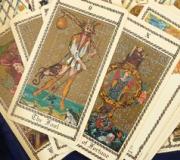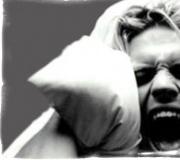Draw a glass of water with gouache step by step. How to draw a glass and other transparent objects
In this article you will find basic rules for working with transparent objects that will help you achieve the desired result with ease:
- Use a basic nine-point shadow scale, where 0-1 are the lightest areas (highlights and reflections of light), and 8-9 are the darkest (furrows and massive areas of glass)
- Remember that glass is not completely flat. Therefore, when drawing the shape of an object, do not forget to also work out the thickness of the glass.
- A shadow falls on the glass. You read that right, even transparent objects have shadows. Very often beginners forget about this.
Let's try to draw a transparent object together. Today it will be a glass with quite complex shapes. Follow the step-by-step instructions - and you will certainly succeed!
Step 1
Let's start with sketches. To make it easier to navigate later, mark the places where there will be glare.

A little life hack on how to indicate the main highlights on glass. When light hits an object from a single source, there are usually two main highlights at the edge of the ellipse, as shown in the figure.
Step 2

Apply masking fluid to all areas where light reflects on the glass. In the picture you can see green spots, this is the masking liquid.
Step 3

Make the first fill. Once the masking fluid has dried, use a brush to wet the entire surface of the paper with clean water. Without waiting for the paper to dry, use a grayish-blue color to paint the shadows on the glass and the shadow that the glass casts on the surface. Wait until the paint is completely dry.
Step 4

Apply a second coat of fill. This time make the cast shadow darker, fill the glass itself with a warm gray shade, and apply a little yellow to the front of the glass to show that light is falling on it. Let the paint dry.
Step 5

Fill the background. Wet the background part of the design with clean water, then fill the background with turquoise blue.
Step 6

We are working on the inside of the glass. Essentially, the inside of the glass is a distortion of the front and back of the background. Using a thin brush, paint the inside of the glass. Use the same shades of blue that you used before, because if you use other colors, the glass will look rough and alien.

Fill the bottom of the glass using the same color as the table.
Step 7

Fill the inside of the glass with a second layer, using a darker shade than the previous time.
Step 8

Fill the last layer. Using colors that correspond to 8-9 on your shade scale. This color scheme will give the glass the necessary shapes and make the thickness of the glass more expressive.
After the paint is completely dry, remove the masking fluid.
Step 9

Apply a light coat of fill to the reflections that are on the shadow side.

After removing the masking fluid, these areas may be too noticeable against the background of the shades used. To make the reflections look harmonious, fill them with diluted bluish-gray paint, as if muting the color.
This is what your painting will look like when completed.

In this tutorial we used masking fluid to maintain the effect of transparency and create clear highlights on the glass created by reflecting light. By following three simple rules and step-by-step instructions, you will be able to realistically convey transparent forms, correctly placing emphasis on highlights and more massive areas of the transparent surface.
The big holidays are coming soon, New Year, Christmas. They were installed specifically in winter, as it is a good way to gather people around the table when it is -40 degrees outside. Women will prepare a lot of delicious dishes, men will decorate the Christmas tree, dress in suits. But what any holiday table cannot do without is good booze. No, not vodka, but wine, champagne. In this lesson we will learn how to draw a glass. As planned, the glasses were created specifically for drinking wine. But over time, people demanded specific cups for different types of drinks.
Interesting things:
- Classic champagne glasses were made in the shape of the breasts of Queen Marie Antoinette of France.;
- More than once you may have heard that the shape and type of glass directly affects the flavor of the drink. In fact, there is no experiment that confirms this myth. All you can do is pretend to be smart in such situations.
- The quality of champagne is not determined by the number of bubbles. Champagne fizzes when poured into dirty dishes. The more dust or fluff in the glass, the more the drink will fizz. Therefore, responsible owners pour champagne into a wet glass.
How to draw a glass with a pencil step by step
Step one. Draw a small circle on top, an oval on the bottom and connect them with a straight line so that it divides the two shapes in half.  Step two. We draw the edges of the glass using smooth, symmetrical lines. We turn the line in the middle into a leg by drawing a vertical rectangle through it.
Step two. We draw the edges of the glass using smooth, symmetrical lines. We turn the line in the middle into a leg by drawing a vertical rectangle through it.  Step three. Now, in the top figure we create a glass from the lines. Everything should be as precise and symmetrical as possible, fine workmanship, these glasses.
Step three. Now, in the top figure we create a glass from the lines. Everything should be as precise and symmetrical as possible, fine workmanship, these glasses.  Step four. The preparations are complete. We remove all those lines that we worked so hard on in the first steps, and outline the contours with an increasingly thick line.
Step four. The preparations are complete. We remove all those lines that we worked so hard on in the first steps, and outline the contours with an increasingly thick line.  Step five. Let's finish drawing the drink that is poured into the wine glass and add more natural shadows. It should work out something like this.
Step five. Let's finish drawing the drink that is poured into the wine glass and add more natural shadows. It should work out something like this.  I always appreciate it if you share your thoughts and comments with me. Don't forget to write me your impressions about the site
I always appreciate it if you share your thoughts and comments with me. Don't forget to write me your impressions about the site
It’s also interesting to depict everyday objects. Especially if, during the drawing process, you tell the child about the purpose of this or that thing. Then the baby will know how to use the item.
The glass seems easy to use. But what if it crashes? Try to familiarize your child with the rules of cleaning so that the baby does not get hurt. You will need: a sheet of paper; pencil; ruler; eraser;
Step 1
The basis
Draw a rectangle with which we will draw a glass. It is needed to ensure that all the details are smooth and do not go beyond the boundaries.
Top part
The oval that represents the top is divided down the center by a horizontal rectangle line. 
Step 3
Lower oval
But the lower oval is not in the middle. Most of it is shifted inside the rectangle. This is necessary in order to correctly connect the parts of the glass. The oval should be smaller than the first one, since the glass tapers slightly downwards. 
Step 4
Removing the base
Remove the base carefully so as not to touch the ovals. The figures should be visually on the same line. 
Step 5
Compound
We connect the ovals with straight lines.  Use a ruler to ensure that the connection lines are straight.
Use a ruler to ensure that the connection lines are straight. 
Step 6
Adjustment
The inner part of the lower oval is not visible to us. That's why we wash it. 
Step 7
Bottom
The bottom of the glass is much thicker than the walls. Mark it with a curved line. 
Step 8
Walls
Draw the walls very close to the outlines, as they are thin.  Connect the walls to the bottom. To avoid mistakes, you can also use a ruler here.
Connect the walls to the bottom. To avoid mistakes, you can also use a ruler here. 
Step 9
Water
The water line can be drawn higher and lower.  Draw a glare of light on the water. This will give the liquid volume.
Draw a glare of light on the water. This will give the liquid volume. 
Step 10
Bubbles
Even if the water is not carbonated, bubbles will appear in it over time. Draw them in random order. 
Step 11
Bottom parts
The bottom shows light, so draw the pattern using curved lines. 
Step 12
Tracing
Draw subtle lines on the rim of the glass. Thanks to them, the rim will appear round. 
Step 13
Coloring
Color the glass as shown in the picture: blue and light blue, since the glass and the water are transparent. 
Step 14
This thing causes heated philosophical debate among fans. Some say that it is always half full, others that it is always half glass. In principle, we don’t care who is right, but it would be nice to know how to draw a glass. A glass is a device for storing something, of any temperature and consistency, and also as a room for a caught butterfly. There are many modifications of it: Faceted, Chemical, Disposable, Folding, etc. Scientific and not so scientific things:
- Mystically, only a cut glass is difficult to accidentally break; all other glassware breaks constantly;
- There is such a device in almost every home, which means we are being watched;
- It can be full or empty, but not at the same time;
- Chuck Norris can drink from two of these glasses at the same time;
- There is no truth at the bottom of this dish, it has been verified;
Drawing it is not as easy as it seems:
How to draw a glass with a pencil step by step
Step one. Clearly define the shape of the glass by drawing two circles and connecting them with corresponding lines. Divide each circle into even sectors.  Step two. Add a few more circles on top inside.
Step two. Add a few more circles on top inside.  Step three. Remove the sector lines and draw several vertical lines.
Step three. Remove the sector lines and draw several vertical lines.  Step four. All that remains is to add shadows.
Step four. All that remains is to add shadows.  Try drawing other decorative and beautiful things.
Try drawing other decorative and beautiful things.
Drawing a mug is not as easy as it seems. It has its own form, which you need to be able to convey. This will require basic drawing skills and knowledge of perspective. Imagine that the mug is a cylinder. Try to look through it. You will see ovals that are at the bottom and at the top. Also, light and shadow fall on the cylinder, which is darkest at the border. And there are reflexes that form at the junction of an object and paper.
Learn how to draw a mug with a pencil step by step using simple drawing skills. Sharpen your pencils, let's begin!
Drawing details
First of all, outline the main proportions. Draw a line that runs down the center of the mug's cylinder (that is, not including the handle).
Draw two ovals to represent the edges of the mug and saucer. Notice that the oval at the bottom is wider than at the top. This arises due to the nature of perspective. That is, the ovals are not symmetrical.
Inside the top oval, draw another one, 3-5 mm smaller in size. This forms the neck of the cup. Use smooth lines to show its shape. But what if you get it wrong and you can’t understand why or how?
It's easy to draw a mug with a pencil. To make the lines as even as possible, it is better to draw from top to bottom - it’s more convenient. Guide the pencil firmly. Be sure to sharpen the lead.

- Draw the bottom of the cup to show its volume.
- Afterwards, during the work process, this oval will not necessarily be erased.
- Outline the guideline for the handle, leaving an oval to which it will be attached.
- Draw a small oval inside the other one, which is intended for the saucer (this is important even in how to draw a mug). This will show its thickness. It will be clear that the mug is not standing on a napkin, but has some kind of voluminous plate.

Draw the shape of the handle. Mark a curved line at the bottom to indicate that the handle will be attached there. The cup has a stand attached to the bottom. Show this with an oval.

Complete the shape of the handle, and also show another oval inside the cup, which will indicate the level to which it will be filled with the drink.

Draw the details at your discretion, compare the proportions. Erase the guide lines.

Hatching
Drawing light and shadow is the main job. You should pay special attention to this if you want to draw a mug step by step. The sketch should take no more than 15 minutes. And to shade correctly, beginners need half an hour. Apply strokes horizontally in a semicircle, then you can easily convey the cylindrical shape and volume of the mug.
Light and shadow
Can't make the image look realistic? How to draw a similar mug, knowledge in drawing light and shadow will help you. The latter may occupy half or less of the image. Also, a shadow can cover an entire object. Its location depends on the lighting.
In high light, the shadow on the subject will be slanted. The cast shadow will lie on the surface closer not to a horizontal position, but to a vertical one, but still with an inclination in a certain direction.
If the light source is on the side, then the shadow will be vertical on the cylinder and occupy a certain part. And its size will depend on the angle from which you draw. The cast shadow will lie horizontally.
If the light is behind the subject, the shadow will completely cover it. Contrasting outlines will appear. But the gradient and cast shadow will also remain. In this case, it is more difficult to draw - you need to try not to make the cylinder too dark, especially if it is made of plaster. Otherwise, the texture will appear metallic. And instead of white, another, darker color will be visible. Now imagine how difficult it is to transfer a bust to paper, while drawing a mug is as easy as shelling pears.

Gradation
From light to dark the gradation is more gradual, and from high light gradually increase the tone, which increases the strength of the shadow of the object, and gradually becomes a shadow. In this case, the shadow also becomes darker from bottom to top. At the junction with the surface it is the lightest.

The drawing imperfectly represents gradation in which there are no sharp changes from one element to the next. In the base light, shadows usually appear where they come into contrast with the highlights. Also, in any lighting conditions there are gradations. At the junction with light, the shadow is darkest in tone. After this junction, the shadow is softer and darkens again towards the edge of the cylinder, but does not become the heaviest in tone. This knowledge even helps in how to draw a mug, because it also has a cylindrical shape.
Cast shadow
The shadow is not completely horizontal. She walks with an upward slope. But it can be positioned differently, depending on the lighting. The shadow that is closest to the cylinder is the darkest. And it also has a gradient - from the object to the junction with the wall. Shadows soften as you move away from the subject. The shadow also has an outline. When you show it, try to make an outline, not a stroke. The shadow that falls on the wall is darker than even a cylinder.




